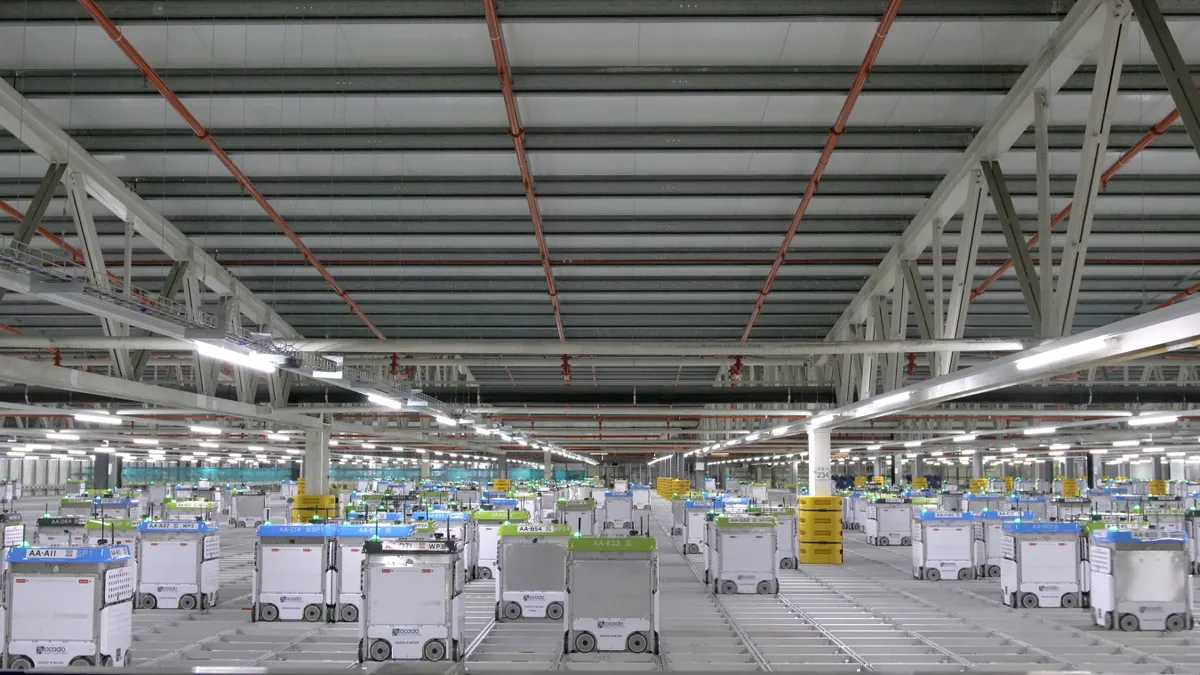Dive Brief:
- Kroger plans to build its second and third Ocado customer fulfillment centers (CFC) in Central Florida and the Mid-Atlantic region, according to a press release.
- Kroger plans to build 20 CFCs across the U.S. in partnership with Ocado. Each facility, also referred to as a "shed," utilizes AI-enabled robots to fulfill orders quickly and at a high volume.
- The first automated facility, announced last November, is currently under construction in Monroe, Ohio, just outside Cincinnati.
Dive Insight:
The locations of Kroger's newest automated facilities highlight two very interesting parts to its Ocado strategy.
By planting a CFC in Florida, where aside from a smattering of Lucky's Market locations it doesn't have a store presence, Kroger is showing it intends to use the facilities to reach new markets. Kroger may place the facility between Orlando and Tampa — two cities separated by about 80 miles that have the density to support a high-volume e-commerce operation and have experienced significant population growth in recent years.
The move adds a new dimension to a grocery battle that's unfolding in a state dominated by Publix. The legacy company has a first-class store fleet, unrivaled customer loyalty and same-day delivery as well as pickup through Instacart. In recent years, though, Walmart has challenged the grocer with remodeled stores and a growing e-commerce business, while new players like Sprouts Farmers Market, Aldi and Earth Fare have elbowed their way in.
Kroger's move amounts to a hefty bet on e-commerce shopping — and particularly the pure-play online grocery model that has proven challenging for the likes of Amazon and Ahold Delhaize.
Its Mid-Atlantic CFC, meanwhile, can serve as a support center for its Kroger and Harris Teeter locations. CEO Rodney McMullen has said the automated warehouses would help supply click-and-collect orders. In a recent interview with Grocery Dive, e-commerce expert and Brick Meets Click chief architect Bill Bishop said the facilities could eventually stock store shelves, too.
A question mark with both facilities — and with the Ocado model overall — is speed. Its massive CFCs can quickly and cost efficiently assemble orders, but they have to be located outside metropolitan areas, making on-demand delivery problematic. Ocado is set to test a one-hour delivery service called Zoom next month in London, and CEO Timothy Steiner has indicated the service will eventually come available for its international clients.
Earlier this month, Ocado's main fulfillment center in Andover, England, which handles 10% of the company's orders in the country, experienced a massive fire. Nobody was hurt in the blaze, and the company plans to quickly rebuild, though experts are beginning to question the safety and stability of the CFC model in light of the incident.
As Coresight Research noted recently, "The fire highlights the risk of the centralized distribution model, which is virtually unique to Ocado in the U.K. online grocery space; most of Ocado's online grocery rivals in the U.K. rely heavily on in-store picking, dispersing risk of disruption among hundreds of local stores."
The company doesn't appear to be making any public shifts to its strategy after the fire and the decision to announce two more CFCs shortly after the incident shows that it remains committed to its current model for the time being.















